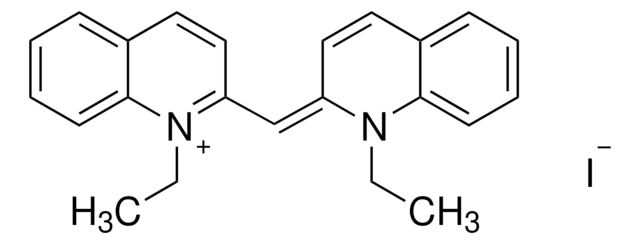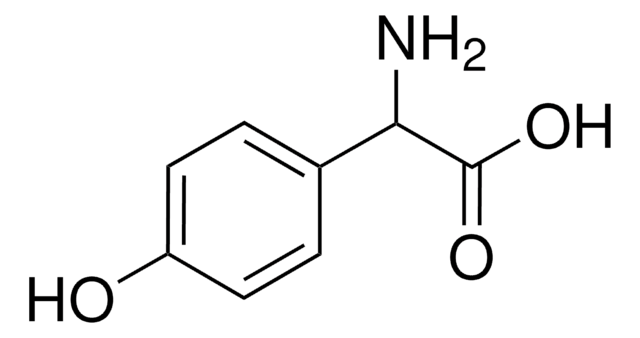Wszystkie zdjęcia(1)
Key Documents
224529
3-Chloro-4-hydroxyphenylacetic acid
99%
Zaloguj sięWyświetlanie cen organizacyjnych i kontraktowych
About This Item
Wzór liniowy:
ClC6H3(OH)CH2CO2H
Numer CAS:
Masa cząsteczkowa:
186.59
Numer WE:
Numer MDL:
Kod UNSPSC:
12352100
Identyfikator substancji w PubChem:
NACRES:
NA.22
Polecane produkty
Poziom jakości
Próba
99%
Postać
powder
mp
108-110 °C (lit.)
grupa funkcyjna
carboxylic acid
chloro
ciąg SMILES
OC(=O)Cc1ccc(O)c(Cl)c1
InChI
1S/C8H7ClO3/c9-6-3-5(4-8(11)12)1-2-7(6)10/h1-3,10H,4H2,(H,11,12)
Klucz InChI
IYTUKSIOQKTZEG-UHFFFAOYSA-N
Opis ogólny
3-Chloro-4-hydroxyphenylacetic acid is an auxin influx inhibitor. It is one of the major chlorinated metabolite of chlorotyrosine.
This page may contain text that has been machine translated.
Hasło ostrzegawcze
Warning
Zwroty wskazujące rodzaj zagrożenia
Zwroty wskazujące środki ostrożności
Klasyfikacja zagrożeń
Eye Irrit. 2 - Skin Irrit. 2 - STOT SE 3
Organy docelowe
Respiratory system
Kod klasy składowania
11 - Combustible Solids
Klasa zagrożenia wodnego (WGK)
WGK 2
Temperatura zapłonu (°F)
Not applicable
Temperatura zapłonu (°C)
Not applicable
Środki ochrony indywidualnej
dust mask type N95 (US), Eyeshields, Gloves
Wybierz jedną z najnowszych wersji:
Masz już ten produkt?
Dokumenty związane z niedawno zakupionymi produktami zostały zamieszczone w Bibliotece dokumentów.
Petr Hosek et al.
Journal of experimental botany, 63(10), 3815-3827 (2012-03-23)
The molecular basis of cellular auxin transport is still not fully understood. Although a number of carriers have been identified and proved to be involved in auxin transport, their regulation and possible activity of as yet unknown transporters remain unclear.
Ali R Mani et al.
The Journal of biological chemistry, 282(40), 29114-29121 (2007-08-10)
During inflammation, neutrophil- and monocyte-derived myeloperoxidase catalyzes the formation of hypochlorous acid, which can chlorinate tyrosine residues in proteins to form chlorotyrosine. However, little is known of the metabolism and disposition of chlorotyrosine in vivo. Following infusion of deuterium-labeled [D(4)]chlorotyrosine
H Nguyen et al.
Toxicology, 160(1-3), 207-217 (2001-03-14)
Exposure to airborne pollutants such as tobacco smoke is associated with increased activation of inflammatory-immune processes and is thought to contribute to the incidence of respiratory tract disease. We hypothezised that cigarette smoke (CS) could synergize with activated inflammatory/immune cells
B A van de Pas et al.
Applied and environmental microbiology, 67(9), 3958-3963 (2001-08-30)
The amount of energy that can be conserved via halorespiration by Desulfitobacterium dehalogenans JW/IU-DC1 was determined by comparison of the growth yields of cells grown with 3-chloro-4-hydroxyphenyl acetate (Cl-OHPA) and different electron donors. Cultures that were grown with lactate, pyruvate
I Utkin et al.
Applied and environmental microbiology, 61(1), 346-351 (1995-01-01)
Resting cells of Desulfitobacterium dehalogenans JW/IU-DC1 growth with pyruvate and 3-chloro-4-hydroxyphenylacetate (3-Cl-4-OHPA) as the electron acceptor and inducer of dehalogenation reductively ortho-dehalogenate pentachlorophenol (PCP); tetrachlorophenols (TeCPs); the trichlorophenols 2,3,4-TCP, 2,3,6-TCP, and 2,4,6-TCP; the dichlorophenols 2,3-DCP, 2,4-DCP, and 2,6-DCP; 2,6-dichloro-4-R-phenols (2,6-DCl-4-RPs
Nasz zespół naukowców ma doświadczenie we wszystkich obszarach badań, w tym w naukach przyrodniczych, materiałoznawstwie, syntezie chemicznej, chromatografii, analityce i wielu innych dziedzinach.
Skontaktuj się z zespołem ds. pomocy technicznej









